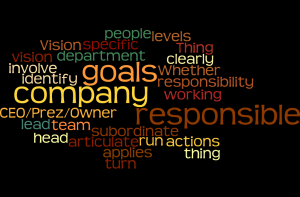|
|
|
Wednesday, September 14th, 2016
 Being a great boss is hard work; it doesn’t always come naturally. Being a great boss is hard work; it doesn’t always come naturally.
Being a boss means understanding the importance of culture.
- “I came to see, in my time at IBM, that culture isn’t just one aspect of the game—it is the game.” –Lou Gerstner, IBM turnaround CEO
Being a boss means clarity throughout 360 degrees of your communications, i.e., subordinates, peers and bosses.
Great bosses
- provide their people with all the information needed to understand how to perform their work as correctly, completely, simply, and efficiently as possible.
They do this by
- providing clear, concise, and complete communications at all times.
Being a boss means a strong focus on hiring.
Great bosses hire smart.
- “Don’t hire jerks, no matter how talented.”
Great bosses hire sans ego.
- “There’s two ways to manage. You can hire to be the smartest person in the room or you can hire to be the dumbest person in the room.” –Michael Lebowitz, founder and C.E.O. of design firm Big Spaceship (He says he works at being the dumbest.)
Being a boss means many other things, too, but master these three and you’ll be well on your way to being a great boss.
Image credit: Hiking Artist
Posted in Communication, Culture, Hiring | No Comments »
Thursday, August 25th, 2016
 My part of this post will be a brief, because I want to be sure you use the link I’m going to give you. My part of this post will be a brief, because I want to be sure you use the link I’m going to give you.
Have you ever noticed that when a subject, word or name comes up you suddenly start running into it from all sides.
Last week’s Entrepreneur post look at the challenge of naming a company or product and used CB Insights as a kind of case study.
Today I read an article from Knowledge @ Wharton (it’s worth subscribing) called How (Not) to Name a Company in the Digital Era.
“Name selection is more important now than ever before,” says Alexandra Watkins, founder of brand consulting agency Eat My Words. “Your name has to work harder than it did 20 years ago.”
Driving the charge are shifts in technology and consumer habits. The ubiquitous presence of internet domain names and web addresses, or URLs, social media and the prevalent use of smartphones and tablets with their smaller screens call for new rules on how a company, product or service should select its name, marketing experts say.
I thought it was very good and sent it to several serial entrepreneurs who have been through the naming fire multiple times.
They also thought it was excellent and said to share it.
So I am.
Now click the link.
Image credit: Wharton
Posted in Communication, Entrepreneurs | No Comments »
Monday, June 13th, 2016
It’s amazing to me, but looking back over a decade of writing I find posts that still impress, with information that is as useful now as when it was written. Golden Oldies is a collection of what I consider some of the best posts during that time.
I wrote Verbal Avoidance in 2011, not because it was new, but because it was so prevalent — and since them it’s gotten more so in spite of all the talk about honesty and authenticity. Read other Golden Oldies here
 There’s a bad habit I see sweeping through companies. It’s not really new, but it has gotten much worse in recent years. There’s a bad habit I see sweeping through companies. It’s not really new, but it has gotten much worse in recent years.
This particular habit used to be more the province of arguing couples, relationship counselors and divorce courts.
Always more of a guy thing, I now find it on the rise among women.
I call it “verbal avoidance” and it is irritating to say the least.
It occurs when something happens, or is supposed to happen, and person A needs to communicate that to person B.
And doesn’t.
A doesn’t because
- what happened is going to upset B and A either doesn’t want to be the messenger, since messengers are sometimes killed or deal with the fallout if/when B gets upset.
- B is waiting for A to notify him of good news, but B doesn’t have the information yet, so rather than saying that, he doesn’t call.
Of course there are dozens of variations, but they all boil down to the same thing—A does not communicate with B as expected.
When B does reach A, A offers a variety of reasons why the contact didn’t happen, but reasons don’t excuse anything.
B feels frustrated/disappointed/disgusted/angry/betrayed.
Verbal avoidance for any reason breaks trust.
And trust is the basis for any kind of relationship, whether at work, at home or in the world at large.
Silence isn’t always golden.
Stock.xchng image credit: Sigurd Decroos
Posted in Communication, Golden Oldies, Personal Growth | No Comments »
Tuesday, January 5th, 2016
KG sent this to me and I had to share it, in spite of the cease and desist letter I may get from the lawyers.

And for great information on how to avoid being a pointy-haired boss check out the January Leadership Development Carnival.
Image credit: Scott Adams
Posted in Communication, Culture, Ducks In A Row, Personal Growth | No Comments »
Wednesday, October 21st, 2015

I wrote the following in 2008 and, based on a number of recent questions/conversations I think it’s time to post it again, with some light editing.
The Vision Thing
Whether you head a company, run a department, or lead a team, you are responsible for that ‘vision thing’ as it applies to those subordinate to you.
It’s your responsibility to clearly identify (if you are the CEO/Prez/Owner) or articulate (at all other levels) the goals of the company.
Then it’s up to you to involve your people, working with them to turn those goals into specific actions for which they are responsible.
Most people are vaguely aware that work isn’t done in a vacuum, but often individuals, teams, or even departments, fail to truly understand the domino effect created by allowing their schedule to slip.
You can minimize this problem, and improve the quality of your workforce, by making certain that they understand how their own goals, their colleagues, those of the company and its customers and vendors interact.
The biggest rewards at all levels (using whatever incentives are available) should go to those who understand the company’s goals, and ethically do whatever is necessary to achieve them—especially when they put the company’s goals ahead of their own.
None of this is rocket science.
It’s simple enough.
No matter your level, if you’re the boss communicating the vision to your team and aligning their actions with it is your responsibility.
Otherwise, the vision becomes a dream.
Image credit: Wordle
Posted in Communication, Personal Growth | No Comments »
Tuesday, October 6th, 2015

I hear a lot form bosses who want to build good culture, but are frustrated because of an excess of how-to information — much of it contradictory.
By popular request here are the only two things you need to know to build an effective culture — everything else flows from them.
First, you have to believe the basic premise.
- People are intelligent, motivated and want to help their company/boss succeed.
Second, you need to back that belief up with appropriate action.
- Provide your people with all the information needed to understand how to perform their work as correctly, completely and efficiently as possible.
Culture frames workplace relationships and, like any relationship, it’s about open communications.
Sharing information is a sign of trust and encourages people to become more involved.
When people know about their job/company/industry and how they all interact, they will perform their own duties better and more productively — because they understand what’s going on they are encouraged to take more ownership and care.
Valuing people and open communications are the bedrock of a great culture and a boss people want to work for.
Bottom line, what to do is simple.
Doing it takes discipline.
Flickr image credit: Mike M
Posted in Communication, Culture, Ducks In A Row | 1 Comment »
Tuesday, September 29th, 2015

All people interactions, whether short or longer, are, in fact, “relationships.”
They are grown and sustained through good communications.
When people are peers, both are responsible for making good communications happen — or should be.
However, when one person outranks the other it becomes the higher ranking person’s responsibility.
As a boss, what do you need to do to be sure you are heard?
What to do is simple; doing it takes effort.
Start by accepting that all people have a mental model through which they hear, so what they hear may have little-to-nothing to do with what is said.
The worst mistake a boss (or anyone) makes is assuming that the person listening has the same model as you.
That said, here is a three-point plan to make sure you are heard.
- Start by carefully explaining your model and your assumptions when giving direction;
- give your people clear, complete information; you do not want to be known as an information drip, i.e., the boss that makes her people come back again and again to fill in the details; and then
- check to be sure that they have actually heard and understood what you mean, as opposed to their version of it.
Do it today, do it all the time and it will become second nature.
Your payback will come in rising productivity, more motivated people, and lower turnover—all positively affecting your bottom line.
Flickr image credit: Graham Dean
Posted in Communication, Ducks In A Row | 2 Comments »
Thursday, March 26th, 2015

“I sometimes say things — just stupid, little remarks — and expect people to just ignore them. They will not. They will not. Every little thing you say is something that will stick in people’s heads.” –Amazon CTO Werner Vogels
Livefyre CEO Jordan Kretchmer, said that he’s made a “benign comment that pissed off the whole sales team.”
Chief product officer of Interaxon, Trevor Coleman, said that once at a happy hour he joked about taking the company in a completely new direction. The following day, an employee asked him — quite seriously — what the next steps for that change would be.
LinkedIn CEO Jeff Weiner said that every offhand comment he made would turn into a “massively disruptive fire drill…”
There is no such thing as a benign or casual comment, throwaway thought or product/strategy-related joke when you are a senior manager.
This is nothing new. I wrote about the same thing in 2006 and the event I described happened 20 years before that.
The question isn’t how to mitigate the damage; the real question is how do we change the thinking that fosters it in every new generation of leaders.
Image credit: Ben Beltran
Posted in Communication, Entrepreneurs, Personal Growth | 1 Comment »
Tuesday, December 9th, 2014

As workloads have increased, companies are pushing people to move faster and faster—often to the company’s detriment.
At the same time employee engagement (AKA, giving a damn) has been plummeting like a rock.
This is especially true when it comes to written communications.
Whether errors are from lack of knowledge or carelessness doesn’t change their effect on readers.
Some errors just make a company’s workforce look ignorant and uneducated (here’s a list of 15 common errors), but some can make it a laughingstock and cost big-time.
Consider the effect of a spelling error on Sephora.
In the lead up to its launch in Australia Sephora has made a doozy of a spelling mistake, leaving out the ‘o’ in its #countdowntobeauty hashtag on Facebook.
Social media is having a field day and it’s doubtful it will go away any time soon.
Obviously, the error wasn’t intentional; it’s more likely the result of not taking time to proof the copy, whether from being overloaded or just sloppy.
Either way, the damage is done.
Here are three simple things you can do to avoid finding your company in a similar situation.
- Spell and grammar check should be the default on all company computers—executives and senior personnel aren’t immune to errors.
- For critical content, writing and proofing should be done by different people; the second person is less likely to unconsciously correct an error.
- Budget enough time to allow for proofing; reading a sentence backwards makes it easier to catch errors.
Flickr image credit: Jean-Daniel Echenard
Posted in Communication, Ducks In A Row | No Comments »
Thursday, November 13th, 2014

As any founder knows, the course of business isn’t smooth and even the most successful startups hit bumps along the way.
Your people know it, too.
In fact, they often foresee trouble more clearly than you’d like and are quick to act — walking next door to another startup. And they do this whether their information is accurate or not.
That means you need to learn how much, when and how to communicate to your team, but keep in mind that there are no absolute answers, because it depends on the specific subject and situation.
That said, there are general guidelines that will help you with the question.
- How much to share? You should discuss with one or more trusted advisors who have substantial experience rather than with peers.
- When to share? Most crucial is to talk to your people before the rumors start. Rumors are like genies, once out of the bottle they are impossible to put back. Worse, in addition to growing with every telling and spreading through the company, they tend to spread throughout the entire venture ecosystem.
- How to share? Clearly, honestly, no games, no half truths. You hired smart people and they’ll see right through anything else.
Unfortunately, many founders tend to clamp down, say nothing, run scared, freeze, bluster, or some combination thereof.
There are very few things that are guaranteed in a startup, but watching your people walk out the door because you hunkered down, shut up, and hoped no on would notice is one of them.
Flickr image credit: Michael Coghlan
Posted in Communication, Entrepreneurs | No Comments »
|
 Subscribe to
Subscribe to
MAPping Company Success
About Miki 
Clarify your exec summary, website, etc.
Have a quick question or just want to chat? Feel free to write or call me at 360.335.8054
The 12 Ingredients of a Fillable Req
CheatSheet for InterviewERS
CheatSheet for InterviewEEs™
Give your mind a rest. Here are 4 quick ways to get rid of kinks, break a logjam or juice your creativity!
Creative mousing
Bubblewrap!
Animal innovation
Brain teaser
The latest disaster is here at home; donate to the East Coast recovery efforts now!
Text REDCROSS to 90999 to make a $10 donation or call 00.733.2767. $10 really really does make a difference and you'll never miss it.
And always donate what you can whenever you can
The following accept cash and in-kind donations: Doctors Without Borders, UNICEF, Red Cross, World Food Program, Save the Children
*/
?>About Miki
About KG
Clarify your exec summary, website, marketing collateral, etc.
Have a question or just want to chat @ no cost? Feel free to write
Download useful assistance now.
Entrepreneurs face difficulties that are hard for most people to imagine, let alone understand. You can find anonymous help and connections that do understand at 7 cups of tea.
Crises never end.
$10 really does make a difference and you’ll never miss it,
while $10 a month has exponential power.
Always donate what you can whenever you can.
The following accept cash and in-kind donations:
|
 Being a great boss is hard work; it doesn’t always come naturally.
Being a great boss is hard work; it doesn’t always come naturally.













